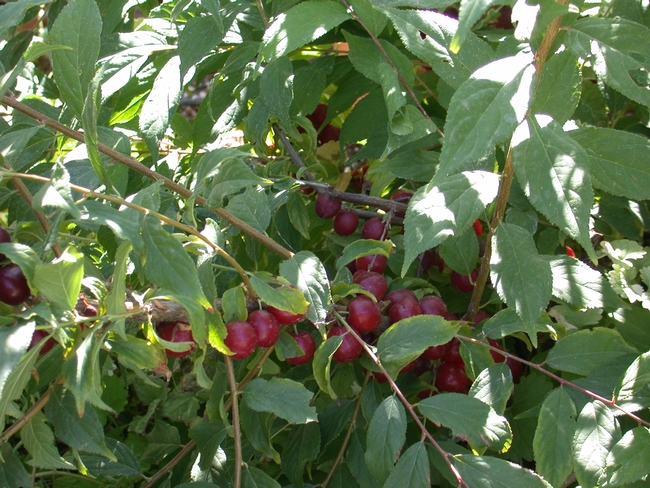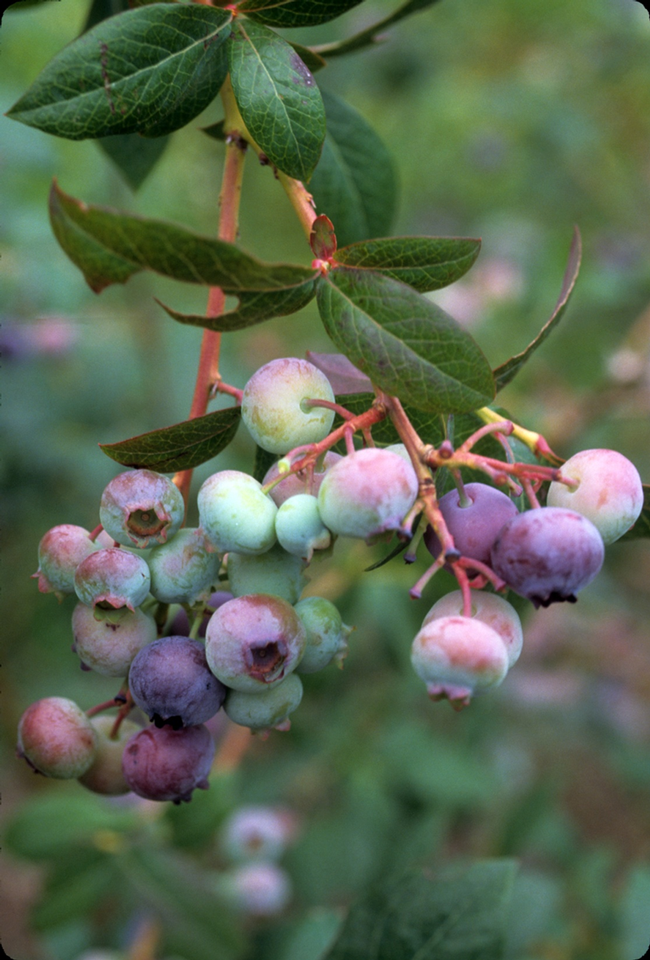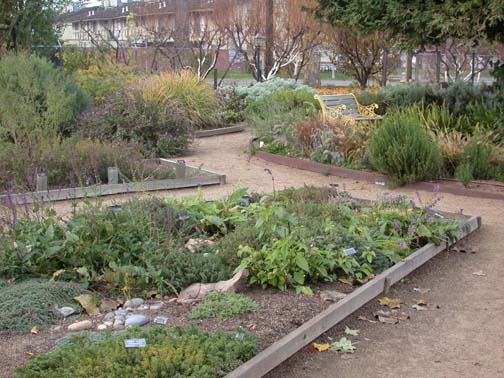Posts Tagged: edible
How to design your landscape and eat it, too
Edible landscapes are growing like zucchini in the sun as more people recognize the health and economic benefits of designing their yards with pretty plants that taste good, too.
“Sales of fruits and vegetables have remained strong, even during this recession when sales of other plants have lagged,” said Ron Hoffman, owner of Morris Nursery in Riverbank,Calif., echoing the sentiments of many in the state’s nursery industry. “People enjoy growing their own produce and they want plants that do double duty.”
And when they choose brightly colored edibles — like, say, Neon Lights swiss chard or Bronze lettuce — they can have their landscape and eat it, too. But designing and maintaining an edible landscape is easier said than done. How do you know what plants to choose? What if one plant needs different soil and more water than its neighbor? How do you keep the cat from pooping on your produce?
The folks at the UC Cooperative Extension Master Gardener Program, with assistance from the California Center for Urban Horticulture at UC Davis, are answering those questions and many more at six, two-day, “train the trainer” workshops throughout the state. Funded by a two-year grant from the UC Agriculture and Natural Resources, the program teaches the art and science of edible landscaping to master gardeners who, in turn, will help train the rest of us.
“Before you install an edible landscape, you need to assess the site and the user,” said Missy Gable, program manager for the California Center for Urban Horticulture. “How much time do you have to devote to gardening? What are your harvest needs? We brought together experts from diverse fields such as landscape architecture, horticulture, food safety and water policy to provide an overview of what’s possible with edible landscaping.”
The workshops are inexpensive — $35 for master gardeners and $65 for industry professionals. In exchange for their reduced rate, master gardeners sign an agreement to teach two classes within three months of their training — one for fellow master gardeners and one for the public. Cheryl Buckwalter, a professional landscaper and executive director of EcoLandscapeCalifornia, attended an earlier workshop and called the experience “invaluable.”
“Today's landscapes need to work harder than ever,” Buckwalter said. “They need to be water and resource efficient, functional and aesthetically pleasing. The Edible Landscaping Workshop not only showed me how to design the multi-functional landscape of today by incorporating edibles, I also feel qualified to educate my clients, the public and other professionals.”
Will the workshops change the way people garden?
“As part of the project, we’ll be looking at that very thing,” said Pam Geisel, director of the UC Statewide Master Gardener Program and the project’s principal investigator. “We will evaluate the impact of train-the-trainer methodologies to determine whether participants adopt more productive, sustainable landscapes as a result of being trained or from training others.”
The benefits of edible landscaping are bountiful. Parents, for example, love exposing their children to both the joy of gardening and the value of healthy food. Farmers appreciate that more people realize produce doesn’t grow on grocery store shelves. But without a few pointers, it’s easy to err with edibles. Sometimes, for example, our eyes are too big for our stomachs.
“Like me,” Gable said. “I’m a plant nerd. This summer I bought four varieties of zucchini because they were so cool. Believe me, no one needs four varieties of zucchini.”
No two yards or gardeners are the same and the course helps people customize their plan to meet their needs. Do you work 12-hour days? Maybe it’s better for you to help out at a community garden than plant too many edibles in your own back yard. Is your garden in full shade?
“Grow blueberries,” Gable said.
There is still room in three Edible Landscaping Workshops this fall: October 26-27 in Los Angeles; Nov. 2-3 in Fresno; and Nov. 30-Dec. 1 in San Luis Obispo. You can register and find more details at http://cchu.ucdavis.edu/events/edible/edible
Could you please pass me the bug kabobs?
Possibly, people could be divided into the following two groups: those who knowingly eat insects, and those who think they have never eaten them. Since I am still assailed by the odd nightmare in which I am bringing to my lips a well-cooked bug that suddenly springs to life, I decided to tackle my bug-food phobia by visiting entomologist Douglas Yanega of UC Riverside last week.
Yanega has eaten insects, even relished them. With no difficulty whatsoever he has ingested honey bees, termites, mealworms, crickets, grasshoppers, ants, June beetles, silkworms and even scorpions.
Eating insects is not unusual in Thailand, Yanega explained. Insects, a good source of highly digestible protein, are part of the diet in Korea, China and Mexico as well.
“You get more bang for the buck when you eat insects, where protein is concerned,” Yanega said. “True, the outer hardened shell is often not digestible, but the softer, internal tissues are. Of course, you want to avoid toxic insects. There are some that could kill you if you ate them.”
How does one know if an insect is toxic? In general, herbivorous insects tend to be more edible. Moreover, insects have evolved to alert other critters — and us! — that they are not suitable for consumption. Bright colors like red, orange or yellow juxtaposed with black on insect bodies are a sure warning from insects that you’d better stay away.
Because few people experiment with eating insects, identifying those that are both edible and delicious can be a big challenge.
“You have, in the middle of the bell curve of insects, a whole lot that are edible but taste awful,” Yanega said. “And there are those at one end of the curve that are just toxic. But at the other end of this curve lie the prized ones: these are edible and tasty.”
In the United States, most people are culturally still averse to eating insects. If you travel to Mexico, however, you might eat stinkbugs, sometimes used to flavor food. Farther off, in Japan, you could enjoy wasp grubs and silkworm larvae. In the mainland parts of Southeast Asia, you can savor giant water bugs and mole crickets.
According to Yanega, one way to get introduced to an entomological diet is to first dry out insects, and then grind them up to a powder.
“You can use this powder as a supplement,” he said. “It’s the easiest way to go about eating insects as food. You can mix the powder into, say, wheat flour to get 'insect-enriched flour.'
If you’re cringing, rest assured that most of us already eat insects unknowingly. Much of food coloring uses insects. The waxy coloring that coats candies is oftentimes insect-based. And a lot of fresh produce has a built-in level of “insect contamination.”
“As long as you are not allergic to an edible insect, you’re safe eating it,” Yanega said. “If you can get past your phobia or stigma of putting bugs in your mouth, you should have no difficulty in adding insects to your diet.”
Which is what most of us would have to do if we found ourselves stranded on an island and famished.
“Should that happen, never mind the brightly colored bugs,” Yanega said. “Instead, go after the ones that are cryptically colored, the ones that look as though they are hiding from something. They would be a much better bet.”
Landscaping? Think edibles
What do Santa Rosa Weeping flowering plum, persimmon, variegated lemon and Tiger figs all have in common? They are all fantastic ornamental plants that produce wonderful edible fruit. There are a variety of fruits and vegetables that can be incorporated into your landscape that produce food for you, your family and your neighborhood. Every landscape should have edibles in it, particularly in light of our goals to produce food closer to home, to conserve water and make the water we do use count for more than irrigating a lawn that nobody ever plays on. Growing your own food feels good and is good for you and your community!
Some simple ideas for incorporating edibles into your landscape are to include fruit as part of your landscape plantings. You might consider an espalier of apples or pears along your western fence; plant an dwarf orange tree on a south facing wall as a large shrub. If you
are in the right climate zone, a dwarf lime or lemon tree is always a hit. A varigated lemon adds interest because the fruit and the foliage are varigated but the flavor is the same as a traditional Eureka Lemon. Limes are also useful in a lot of recipes and it is nice to have one just outside your door for that gin and tonic. Fuyu persimmons make wonderful shade trees that are easy to grow, have few pests and the fruit is tasty eaten fresh or dried. Just don’t plant them over a driveway or patio since the fruit drop in fall may be a bit annoying.Shrubs with edible fruit are great too. Blueberries are lovely garden plants and you will be able to harvest quite a bit of fruit off of one or two plants. You could also plant a compact Stella Cherry (a self-pollenating variety) as a flowering deciduous shrub that will grow to about 10 feet tall but can be kept shorter with summer pruning. You can also grow a variety of citrus as super dwarf plants if they are grown on Flying Dragon Rootstock, which keeps their height to below 6 feet without a lot of pruning.
The area that you can save a lot of money is by putting in an herb garden. The basic plants that every herb garden should have are thyme, chives, rosemary, tarragon, sage, oregano, and an annual planting of basil in the spring and dill in the late summer/fall. While there are a wide variety of herbs that you may want to grow, these few are the most commonly used to season our foods. If you purchase fresh herbs from the grocery story, a small plastic wrapped package with a few sprigs of thyme costs about $2.99. This stuff will grow in lower elevation gardens without difficulty. One plant may cost $2.99 but once established, will provide all the thyme you could use for as long as you have it in the garden.
The key to edible landscaping is to change your ideas of what a landscape can be. Edibles don’t have to be grown in rows or in an area designated as the “vegetable garden." They can be incorporated into your flower beds as part of the ornamental garden. Compact, that is "determinant," tomato varieties that don’t require staking are perfect for sunny beds. If you have room for a ground cover in a sunny area, think of strawberries. If you want to cover a trellis or arbor, grapes can be good but only plant varieties listed as resistant to powdery mildew. Black Monukka is a nice seedless variety that has a medium-sized berry and is relatively pest and disease resistant. Consider that even if you don’t harvest everything yourself, you will have some food that you can share with your neighbors and friends.
For more information on how do grow edibles in your landscape, contact your local Master Gardeners. You can find them on the California Master Gardeners' websites.

ripe plums









